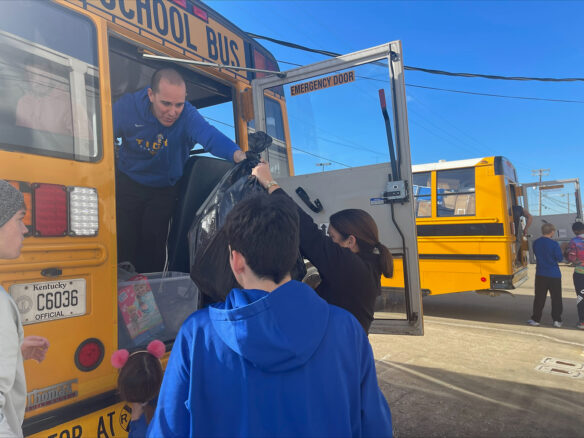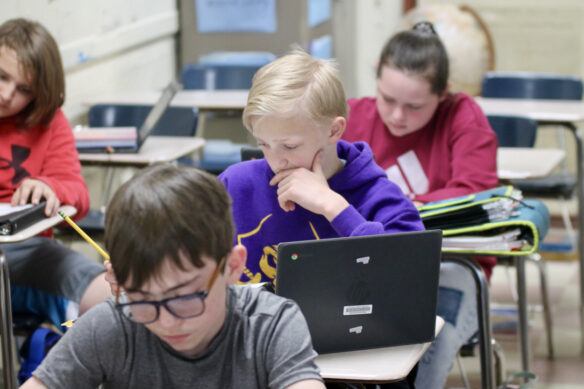On Dec. 10, 2021, Mayfield High School in western Kentucky became a triage center after the tornadoes. Joe Henderson, superintendent of Mayfield Independent Schools, remembers the night like it was yesterday.
“In small communities, people look to the schools for support and help,” he said.
The high school gymnasium served as a place for families with nowhere to go, who had minor injuries or were looking for loved ones. The school district lost its bus garage and is just now slated to finish rebuilding efforts in December 2023.
In Mayfield Independent, Henderson said the focus now is on addressing mental health.
“Anytime now we have any sort of severe thunderstorm warning, people are concerned,” he said.
Three months after the tornado, Mayfield High School served as a different kind of community center – one for rebuilding. The city government invited residents to the high school for the first meeting of “Mayfield Rebuilds,” where community members gave input on how to best move forward.
Schools continued to play an important role in the rebuilding efforts. Another school in the area, Graves County High School, served as the gathering grounds for a memorial one year after the tornado in December 2022.
Dawson Springs had a larger number of students, staff and families displaced by the tornados than many areas of the region.
Fifteen months out, Dawson Springs Independent Superintendent Leonard Whalen said the district is doing well considering the situation, with more students enrolled now than before.
“The wheels are turning and it’s taking time but in a lot of regards, we are far beyond what I anticipated,” Whalen said.
The main concern for the community is getting houses rebuilt. Whalen said there are still people living in makeshift living spaces until a more permanent residence is available. A major government housing complex that served low-income families will start breaking ground to rebuild in Spring 2023.
“Numerous houses are going up, there are a significant number of homes close to completion and newer homes are being started,” he said.
While there are still areas that need to be addressed, such as the rebuilding of a community park that was important for Dawson Spring students, Whalen said the district provides resources and counseling where they can.
“All indications are that our staff and people are resilient,” he said.
The West Kentucky Educational Cooperative (WKEC) has been instrumental in helping build that resilience and meeting the social and emotional learning (SEL) needs of students, their families and staff.
“Resiliency is the ability to be able to bounce back after life’s downturns; it’s something that sometimes takes a lot of work; it’s something with those trainings, people can recognize and work on,” said Sarah Akin, who serves as WKEC’s SEL specialist and regional crisis response lead.

The West Kentucky Educational Cooperative services 23 school districts in Western Kentucky. Following the tornadoes in December 2021, their office served as a distribution site. Now, they help the region through mental health trainings for youth and adults. Photo submitted by Sarah Akin.
WKEC has offered training to staff on adult wellness, focusing on mental health and trauma-informed practices to take care of themselves as they navigate life after the tornado. Resources were developed in partnership with the Kentucky Department of Education (KDE), Kentucky Association for Psychology in the Schools, Kentucky Association for School Social Work and Kentucky Department for Behavioral Health, Developmental and Intellectual Disabilities.
When the one-year anniversary of the tornado rolled around, WKEC shared a toolkit with superintendents to address trauma in school. They said, ‘You must have been reading my mind,’” Akin said.
She said to this day, if districts and schools need them to come, they will provide support.
There are plans to build a memorial garden where the Graves County courthouse once stood. In the meantime, a plaque reads: “We honor those who died due to the violent December 2021 tornado and we also celebrate the spirits of the community that is rebuilding.”
In Eastern Kentucky, education community sprang into action
In Letcher County in eastern Kentucky, homes were wiped out or muddied, storefronts were ravaged, school buildings were rendered useless and lives were upended in the flooding of July 2022. For Yonts, the event was deeply personal.

Floors in several gymnasiums across Letcher County were severely damaged. The wood at Whitesburg Middle School is being installed, Fleming-Neon Middle School and Martha Jane Potter Elementary will soon follow. Photo by Caleb Bates, March 30, 2023
“It’s a blessing to be able to come and work where you grew up,” she said. “And because it is a small community, these people are not just acquaintances or they’re not just school children and families, they’re my family.”
As superintendent, many responsibilities fell upon her after the flooding. Yonts began response and recovery efforts quickly.
She was first concerned for the students her districts serves. Then her thoughts turned to the damage to the district’s infrastructure and what that would mean for those students.
“We had three full school buildings that had six to eight feet of water in them,” she said. “That’s three total buildings. And in those buildings, there’s two cafeterias, three gymnasiums and three libraries.”
Including the district’s central office and an alternative education facility, Yonts said eight campuses needed repairs.
District leaders estimate 1,100 students were displaced from their schools in Letcher County, many facing displacement at home, too.
When Education Commissioner Jason E. Glass visited Letcher County in September, bringing with him other government officials, including the U.S. Department of Education (USDE), the district was unsure of its plans.
Since then, Yonts said the district had made great strides in rebuilding.
“Between that September time and Jan. 1, we have a lot of work that happened, and a lot of good things happened for us,” she said.
The flooded buildings have yet to be completely restored, and while some schools are teaching classes on their campuses again, including Martha Jane Potter Elementary School and Whitesburg Middle School, Yonts said the district has more work to finish.
But the district’s progress will continue moving forward, thanks to assistance and support from agencies like KDE, Yonts said.

Students at Fleming-Neon Middle School have returned to a new normalcy at school. Martha Jane Potter Elementary shared facilities with the school until repairs were made to the campus. Photo by Caleb Bates, March 30, 2023
“I can’t say enough good things about KDE,” she said. “From the very beginning, everyone there has made themselves fully available to us. They’ll hop on a call, they’ll answer any questions we have. They give us advice. They help.”
Superintendent Wayne Sizemore of Jackson Independent Schools also said KDE and the educational community supported his district in its recovery, including the Kentucky Association of School Administrators (KASA), which collected and dispersed coats in a winter coat drive.
“I can’t say enough about what Kentucky Department of Education Commissioner Glass and his team did for our district, but also for all districts in the flood-impacted region,” he said. “(The) USDE provided additional support as well and especially through the federal government and FEMA support.”
Sizemore said all the support has allowed his district to better serve its stakeholders.
“The incredible outpouring of support from every entity – nationally, state level, district level, community level, personal level – we’re still continuing to see that support,” he said.
Because Jackson Independent schools sit on a hill, the facilities did not see damage from the flooding. However, many of the district’s students are still displaced.
“We’re still trying to find ways to support them, whether that be through furniture or through clothing,” he said.
In addition to meeting physical needs, Jackson Independent staff has been working to help students recover mentally from the trauma that came from flooding.
Sizemore said Jackson Independent’s Family Resource and Youth Service Center (FRYSC) received a grant as part of the Governor’s Emergency Education Relief (GEER) fund. The grant funds educational support services focused on supporting students’ mental health because of COVID-19’s impact on communities.
As time progressed, the number of students the program serves increased, from around 35 students when it started to about 76 now. The district hosts the program three days per week.
“It’s just an opportunity for us to provide more supports for our students and we are seeing families take advantage of that,” he said.
Despite the community’s struggles, he said he is optimistic about recovery efforts with the support of Kentucky’s educational community. But most of all, the hope that comes from the resilience of its people.

